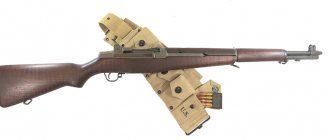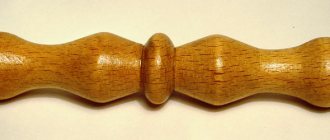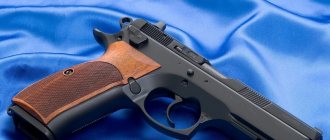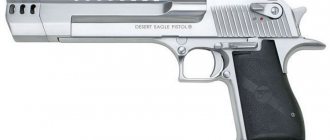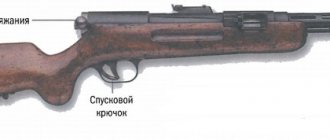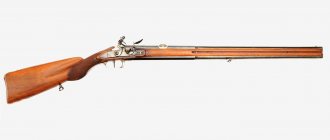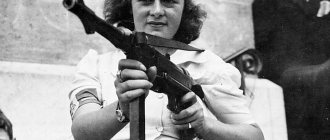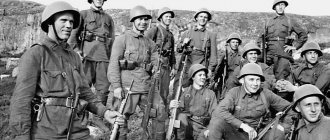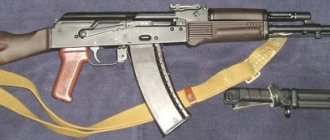Japanese special forces weapons
Japanese paratrooper in full equipment
The combat experience gained by the Japanese army and intelligence services during the Second World War, including during reconnaissance and sabotage operations, was lost with the defeat of militaristic Japan. The year 1945 drew a line under the history of the Japanese Empire in the first half of the twentieth century. After the departure of the American administration, which left Emperor Hirohito on the throne but took away real power from him, the new liberal administration was able to recreate the army and intelligence services only in the mid-1950s.
Currently, in accordance with the new structure, the Japanese special forces system consists of the 1st Kutei Airborne Brigade and a separate anti-terrorism detachment under the Naiho Security Service (civilian intelligence, counterintelligence and security service).
The 1st Kutei Airborne Brigade was formed in 1955 as part of the Japanese Self-Defense Forces. Personnel training was conducted by Americans from the 187th Airborne Regimental Command on the island of Kyushu. In the 1960s, a parachute school opened in the town of Narasino. The training program in it was completely borrowed from the American army - from the basics of individual training of paratroopers to the technique of long jumps.
The brigade is staffed only by volunteers, and the selection of recruits continues for four weeks. Upon completion of basic (main) training in additional courses, paratroopers master the profession of military reconnaissance, mountain shooters or combat scuba divers.
The brigade is based in the vicinity of Tokyo and has 1,200 people in its ranks. It is one of the best units of the Japanese Self-Defense Forces.
Recently, Japan has been making great efforts to re-equip its armed forces, and the Kutei brigade serves as an excellent testing ground for military technologies, both borrowed from the West and developed in the Land of the Rising Sun itself.
Japanese units and special forces are currently armed with modern models of small arms, both developed in Japan and purchased abroad.
SHORT WEAPONS
.45 pistol Colt M 1911A1
After the end of World War II, for a long time the Japanese self-defense forces were armed with American-made weapons, including self-loading Colt pistols of .45 caliber.
Some units, as well as law enforcement agencies, used short-barreled weapons of their own production, including the New Nambu type 57A pistol. The Japanese pistol differed only slightly in design, action and appearance from the standard Colt M 1911A1 pistol of the American armed forces. The New Nambu pistol was designed to use the 9x19 Parabellum cartridge. It had a non-self-cocking firing mechanism.
9-mm pistol New Nambu type 57A
The automatic pistol type 57A worked on the principle of using recoil with a short barrel stroke.
The design features of this weapon include the clutch locking of the lugs on the breech of the barrel with the lugs made on the inner surface of the bolt casing. The Type 57A pistol, unlike the Colt, had only a safety lever located on the left side of the frame. The trigger mechanism had a disconnector that disconnected the trigger sear from the trigger rod. The magazine is single-row with a capacity of 8 rounds. Structurally, the Type 57A pistol consisted of only 43 parts. The effective firing range of this weapon is up to 50 m. The practical rate of fire was 24 rounds/min. .38 revolver New Nambu type 60
Especially for law enforcement agencies, including their special units, Shin Chuo Kogyo K.K. produced the New Nambu type 60 .38 caliber police revolver from 1967 to 1984. This five-shot revolver weighing 0.6 kg is a copy of the American Smith-Wesson “Hand Ejector” M 36 revolver. The weapon was produced in individual versions: with a short or elongated barrel, with a high or low front sight, with a swivel on the revolver handle for attaching a safety cord or without her.
However, these models of Japanese short-barreled self-defense weapons in design terms lagged significantly behind similar weapons from other countries, so in the mid-1970s the command of the self-defense forces was forced to turn to foreign experience.
By this time, Swiss pistols bearing the SIG brand were rightfully deservedly considered one of the best in the world. But the excellent characteristics inherent in these weapons greatly influenced another aspect - due to their too high cost, only a few armies in the world could afford to rearm all army units with a sufficient number of such pistols. The Japanese recognized that a significant number of their weapons tended to represent a compromise between effectiveness and cost. 9-mm pistol SIG-Sauer P.220
In 1974, the Swiss company Schweizerische Industrie-Geselschaft (SIG) from Neuhausen signed an agreement with the West German arms company JPSauer & Sohn from Eckenford on the sale of its shares and the reassignment of the German branch to the Swiss. Such a merger of the research and industrial potential of the most famous arms companies contributed to the strengthening of the influence of Swiss gunsmiths on the international arms market. Already in the same year, 1974, the SIG company proposed its promising development, known under the designation “P.220”. The design of this pistol, created taking into account the proposals of the German company JPSauer & Sohn, turned out to be very successful. The new model of Swiss weapons was designed to use the 9x19 Parabellum pistol cartridge. The automatic operation of the R. 220 pistol worked on the principle of using recoil with a short barrel stroke. The production of these weapons was mastered both at the Swiss factories of the SIG company and at the German factories of the JPSauer & Sohn company.
After a series of tests of new weapons conducted in Japan in the late 1970s, in 1981 the Japanese self-defense forces, intelligence agencies and law enforcement agencies adopted the 9-mm SIG-Sauer P.220 pistol.
AUTOMATIC RIFLES
The command of the Japanese self-defense forces, which were armed with American M.1 Garand rifles and M.1 carbines after the end of World War II, already by the mid-1950s felt a serious lag behind the progress in the development of individual infantry weapons.
By this time, the armed forces of almost all developed countries of the West and East had already finished re-equipping their armies with new models of assault rifles (machine guns). The Japanese, trying to keep up with the general rhythm, in 1957, for the first time after the war, began work on creating their own model of the main infantry weapon - an automatic rifle chambered for the 7.62 mm NATO cartridge. The development of the rifle was carried out by military engineers together with designers from Howa Machinery Company Ltd (in Nagoya) under the general leadership of General Koni Iwashita. Before starting to create promising rifles, the Japanese developed their own ammunition, because, using the 7.62x51 NATO cartridge as a basis, they considered that this cartridge had excess power, which means that the recoil when firing from such a weapon would be too high for short residents of the country rising sun. Soon a special rifle cartridge 7.62x51, later better known as type 64, appeared, with a reduced powder charge (90% of normal). Already in April 1958, the first two experimental automatic rifles R-1 and R-2, the design of which was strongly influenced by the American ArmaLite rifles, were tested at the training ground. After a number of modifications, a new version of the rifle appeared in 1962, known under the symbol R-6. Its automation worked on the principle of removing powder gases from the barrel. The side-mounted gas engine was located above the barrel. The barrel bore was locked by tilting the bolt, reminiscent of a similar unit in the Soviet SKS carbine. The R-6 rifle had a straight butt, which helped improve the accuracy of the battle when firing with both single and automatic fire. According to foreign magazines, the accuracy of combat and the fire efficiency of the Japanese rifle are significantly better than those of other similar rifles. A Japanese soldier fires a Type 64 automatic rifle.
However, the requirements of the Japanese military were constantly increasing, and by 1964 a modernized version of the R-6E rifle appeared, which, after intensive testing, was adopted by the Japanese army under the designation “Type 64.” Many changes were made to its design. The trigger mechanism was extremely unusual in this rifle. Since the rifle was fired from the front sear and the cartridge was in the chamber before firing, during intense shooting there was a possibility of the chamber heating up, which could lead to spontaneous ignition of the cartridge and an involuntary firing. To completely eliminate such self-ignition, Japanese gunsmiths proposed a new design of the trigger mechanism, which, after heating the chamber to a critical temperature, was automatically reconfigured to fire from the rear sear, in which the moving parts were in the rear position before firing, thus allowing forced ventilation of the barrel bore .
The new weapon was significantly shorter and lighter than the main rifles in service in the armies of NATO countries. Thus, the barrel length of this sample was reduced to 450 mm. Due to the low initial bullet speed (700 m/s), the less powerful Type 64 cartridge (when firing standard 7.62 mm NATO cartridges from the M64 rifle, the initial bullet speed was 800 m/s), with the normal weight of the Type 64 rifle ( 4.4 kg) the recoil energy when firing was reduced by about a third.
Stabilization of the weapon during shooting was achieved using a light bipod wire mounted on the barrel in front of the gas outlet. The rifle was equipped with a diopter sight, set at a distance of 200 - 400 m. For firing wall-mounted grenades, a new muzzle brake-flash suppressor was developed, which was also an attachment for rifle grenades. It was possible to install a bayonet on the rifle.
In each Japanese infantry squad (11 people), seven soldiers were armed with Type 64 rifles, with one of them equipped with a telescopic sight and used as a sniper rifle. In 1990, after production of 250,000 Type 64 rifles, their production was discontinued.
Significant combat experience gained during numerous local wars in the 1960-1980s revealed the imperfection of automatic infantry weapons designed to use the 7.62 mm NATO cartridge due to the large dispersion of bullets, especially when firing in continuous bursts.
Therefore, in a number of countries, research and development work was begun to improve the accuracy of automatic rifles by, which was primarily associated with the transition of weapons to a smaller caliber (up to 5.56 mm). Small caliber small arms, in addition to significant advantages over 7.62 mm weapons in terms of combat and maneuverability, also made it possible to improve the economic performance of production. In addition, this was in line with the desire to maintain a longer direct shot range with reduced recoil force. Such properties of weapons designed for a low-pulse cartridge, along with the positive results of the combat use of the American M 16 rifle in Vietnam, became the starting point for the work of gunsmiths from other countries, and in particular Japan, to create samples of such weapons. 5.56 mm ArmaLite AR-18 assault rifle
The first such experience in the production of automatic weapons chambered for a low-pulse cartridge in Japan was the 5.56 mm AR 18 automatic rifle.
In 1961, the leading designer of the American company Armalite Inc. Eugene Stoner developed the 7.62 mm AR 16 automatic rifle specifically for arming tank and armored personnel carrier crews. The new weapon, created for troops operating in difficult climatic conditions, especially in tropical climates, was also extremely compact, since in the transport position the wooden butt folded to the left towards the receiver. The AR 16 rifle was intended to replace the unsuccessful M14 in the military. However, the American army at that time was relying on the new 5.56-mm M16 assault rifle, so even a successful weapon, which was the AR 16 automatic rifle, was not of interest to the leadership of the US Department of Defense.
Considering the high service and operational performance of the weapon, which is quite competitive with other models, Eugene Stoner, together with Arthur Miller, in 1963 redesigned the 7.62 mm AR 16 rifle for the 5.56 mm low-pulse cartridge M 193. A new model, simpler and cheaper than the AR 15, received the name AR 18. This rifle was intended specifically for delivery to third countries.
In 1964, this weapon underwent extensive testing in the United States, but the M16 showed the best results. Therefore, Armalite Inc. it was necessary to establish production of the AR 18 only for the commercial market, including in the version of a self-loading rifle. And only five years later, in 1969, this rifle, which had fairly high combat and performance qualities, found its consumer. Armalite Inc. transferred a license for its production to the Japanese company Howa Machinery Ltd., which began manufacturing the AR 18 for arming special forces of the army and police, as well as for export. At the same time, the Japanese also produced a self-loading version for commercial sale under the symbol AR 180. The main difference between this model and a combat rifle, in addition to the converted trigger mechanism, is the presence of a wooden butt. In 1976, the English company Sterling Engineering Co Ltd, in cooperation with the Japanese company Howa Machinery Company Ltd. established production of the AR 18 in the UK. However, the Japanese government did not then grant Howa Machinery Company Ltd the right to produce military weapons. Despite these problems, a small number of AR 18 assault rifles did enter service with Japanese law enforcement agencies in the late 1970s, including a separate anti-terrorism squad under the Naiho security service.
The Japanese army needed a different, simpler and more reliable weapon. In the mid-1980s, under a contract with the Japanese National Defense Agency, Howa Machinery Company Ltd developed a new assault rifle chambered for 5.56x45 NATO, designated Type 89. Its mass production began in 1990.
SUBMACHINE GUNS
In the first decades after the end of World War II, Japanese self-defense forces and law enforcement agencies were armed with American Thompson, M3 and M3A1 submachine guns.
Only thirty years later, in 1965, the arms company Shin Chuo Kogyo K.K. (SCK) in Tokyo developed a new submachine gun, which in the same year was adopted by the Japanese army under the symbol SCK type 65. This weapon was designed to fire the 9x19 NATO pistol cartridge (Parabellum). 9-mm SCK type 66 submachine gun with folded buttstock
Structurally, the Japanese submachine gun was similar to the Swedish Carl Gustav M.45B submachine gun. Its automation worked on the principle of using the recoil of a free shutter. The trigger mechanism was designed for single and automatic fire. A special feature of the design of the Type 65 submachine gun is an exceptionally well-thought-out safety system for the shooter’s handling of the weapon, consisting of three types of safety devices. An automatic safety, made in the form of a lever located on the front pistol grip, blocks the bolt and prevents a shot as a result of inertial displacement of the bolt. The second safety feature is the extraction window cover, which locks the bolt in the forward and rear positions (depending on where the bolt is located). The third safety prevents a shot from being fired if the hand accidentally slips from the reloading handle while cocking the bolt.
In 1966, the submachine gun, after modernization under the name SCK type 66, was put into mass production.
From a design and technological point of view, the Type 66 submachine gun was a fairly modern weapon, but the Japanese self-defense forces and law enforcement agencies purchased only 6,000 SCK Type 65 and Type 66 submachine guns. Therefore, in Japan for a long time, the main model of this type of weapon was the long-outdated American 11.43 mm MZA1 submachine gun. 9-mm submachine gun MP.5SD3
After lengthy debates, Japanese law enforcement agencies in the early 1980s purchased one of the most successful examples of this type of automatic weapon - the West German 9-mm Heckler and Koch MR submachine gun. 5, which became one of the main types of police special forces weapons in Japan. Along with this, at the end of the 1980s, the Japanese police and special forces of the self-defense forces received special small-sized MP.5K submachine guns. It was a greatly shortened (up to 325 mm) version of the standard MP.5 weighing 2.5 kg (in running order), which could be freely placed under clothing or in any limited volumes.
MACHINE GUNS
In the 1950s, when the Japanese armed forces were re-formed, there was a need to equip them with a single machine gun of their own production.
A Japanese soldier with a single type 62 machine gun mounted on an improvised sled.
This machine gun was developed by designers of the Japanese company Nitokku Metal Industry in Tokyo under the leadership of Massaya Kawamura. This weapon, chambered for a 7.62-mm NATO rifle-machine-gun cartridge (with a reduced powder charge), under the original name Type 9M, was adopted by the Japanese Self-Defense Forces back in 1962 to replace the Browning M 1919 A4 light machine gun imported from the United States. Subsequently, the machine gun was slightly modernized, and its name changed in accordance with new standards in the designation of Japanese weapons. It is currently called the "type 62 single machine gun". And in 1974, its modified tank version “type 74” appeared to equip armored vehicles.
The barrel of the air-cooled machine gun is quick-changeable, like many machine guns previously developed in Japan, and has cooling fins.
The question of the advisability of using these ribs still remains open. Japanese designers explain that this way the barrel is cooled better. Other experts believe that these ribs are contaminated with weapon lubricant, which, when heated during shooting, negatively affects aiming, creating a haze. To separate the barrel, you need to lift the receiver cover (the barrel lock is recessed), turn the carrying handle and separate the barrel, pushing it forward. 7.62-mm single machine gun type 62 with a periscope sight on the M 2 machine (in the easel version)
With the receiver cover raised, the locking wedge of the bolt cannot be raised and, therefore, the wedge hole for the passage of the firing pin cannot be aligned with the firing pin. This eliminates the possibility of feeding a cartridge and firing a shot when the bolt or barrel is not locked.
The machine gun's trigger mechanism is designed for automatic fire only. The cartridges are fed from the left side from detachable belts with a capacity of 50 or 200 cartridges. It is also possible to use standard 7.62 mm NATO cartridges.
In the easel version, the machine gun is used with the American M 2 machine gun, the design of which included a shock absorber developed in Japan.
The length of the aiming line is 590 mm. Both in the easel and hand-held versions, various optical sights can be installed on the machine gun. The machine gun has good accuracy and reliable automation. Effective firing range - 1100 m.
At the end of the 1980s, Nitokku Metal Industry began developing a new 7.62 mm single 19M machine gun. The weight of the 19M machine gun is 9 kg (type 62 -10.7 kg). Low weight is achieved due to the use of titanium and aluminum alloys. The automatic operation of the 19M machine gun operates on the principle of removing powder gases, the rate of fire is 700 rounds/min.
In total, from 1962 to the early 1990s, Nitokku Metal Industry supplied the self-defense forces with just over 3,500 single type 62 machine guns. Currently, a number of type 62 machine guns are still in use in Japanese units and special forces.
.50 heavy machine gun Browning M2НВ
Along with 7.62 mm single machine guns, the Japanese special forces are armed with 12.7 mm American heavy machine guns "Browning" М2НВ. In 1984 - 1985, the Japanese Self-Defense Forces purchased 900 M2NV machine guns.
The automatic machine gun operates on the principle of using energy with a short barrel stroke. It has a weighted and elongated barrel with transverse cooling fins, which made it possible to significantly increase the initial bullet speed (up to 884 m/s) and to some extent reduce the flame exhaust when firing. The braking of the moving parts after the shot is carried out by the knurling spring and the return spring, which significantly reduce the rollback speed of the moving parts. The features of this weapon, in addition, include the fact that the heated barrel allows for quick replacement without completely disassembling the machine gun, which is extremely necessary in real combat conditions. Many technical innovations were made in the design of the M2НВ machine gun: the bolt has a cocking mechanism for holding in the rearmost position; A switch for double-sided tape feeding is mounted. On the receiver, the loading mechanism with a handle can also be installed on either the right or left side. Two trigger levers are mounted in the butt plate, which provide single or continuous fire. For firing at ground targets, the M 2NV machine gun is mounted on a lightweight M3 tripod machine, structurally similar to the M2 machines of the Browning M1919A4 machine gun. With M3 mountings, the Browning M2NV heavy machine gun is used as a heavy infantry fire support weapon. The Japanese army is armed with several more models of the Browning M2NV in tank, armored personnel carrier and helicopter versions. These machine guns have proven themselves to be the best, being powerful, but at the same time simple and reliable weapons to operate.
Sergey Monetchikov Photo from the author’s archive
Victims of bad weather
Most sources agree that the first firearm appeared on Japanese soil in 1543, when a Chinese junk, lost off course due to a hurricane, landed on the shore of Tanegashima Island.
The junk contained three Portuguese traders armed with arquebuses. Old archives say that one of the traders shot a duck, which aroused considerable interest among the then daimyo (governor) of the island. Having quickly negotiated the barrel for the required amount of goodies, and received a couple of lessons in practical shooting, the governor dragged the arquebus to the local blacksmith with a categorical order to figure it out: what the hell is this? And what good can you get out of it? It should be noted that by that time the Japanese already knew gunpowder from the so-called “Mongol expansions”, during which the enterprising Japanese carefully wrote down and sketched everything that seemed useful to them. The problem turned out to be that the gunpowder produced by the Japanese from their own resources was not of very high quality, due to the low content of nitrate in local lands. Therefore, this matter was put on a distant shelf, until better times. And the times have come.
Tsurugi
It roughly looks like this. |Photo: rock-cafe.info.
A Japanese sword, which with a high degree of probability was borrowed and modified by the islanders from the Chinese. The sword was widely used in Japan until the advent of a fundamentally new blade weapon - tachi. The greatest spread of tsuruga occurred in the period from the 7th to the 9th centuries.
Katana
Symbol of samurai. |Photo: sketchfab.com.
Business card of the Japanese samurai. A long two-handed saber (up to 75.7 cm), which appeared as a result of the evolution of tachi. The first katanas appeared quite late - in the 15th century and were used until the end of the 19th century. Traditionally used in a “daisho” (large-small) combination: the katana was worn with its sheath, blade up, paired with a short wakizashi blade.
This is interesting : modern GOST standards for edged weapons define a katana as a “long two-handed saber.”
Bo
Simple and effective. |Photo: doramakun.ru.
A wooden or bamboo staff with a shaft diameter of about 3 cm. It was used mainly in martial arts. In most cases, Bo had a length of 180 cm, but there are also very long examples - 270 cm. Despite its apparent simplicity, a knowledgeable person can kill an opponent with the help of Bo with just a few blows.
Odachi and Nodachi
Some blades are too big. |Photo: ekamer.livejournal.com.
Japanese bladed weapon with a blade length of 130-180 cm and 120 cm, respectively. Such sabers were used exclusively in foot combat. Individual Odachi were so large that they were used exclusively as ritual weapons, serving as symbols of military formation.
Jutte
Means of pacification. |Photo: upcscavenger.com.
A small metal club, which is sometimes classified (for some reason?) as a dagger. The main feature of the Jutte is the absence of sharpening and the presence of a small protrusion-trap for capturing the blade of a bladed weapon. Widely used by city police, as well as ninjas.
Tanto
Another auxiliary weapon. |Photo: gregforge.com.ua.
A Japanese samurai dagger with a blade length of 30-50 cm. Most often, tantos had a sharp edge on only one side of the blade, but double-sided tantos are also found. One of the few types of weapons that were allowed to be owned not only by samurai, but also by wealthy citizens. The tanto was used as a ritual and auxiliary weapon.
Tati
The next step in development. |Photo: turkcewiki.org.
In the 10th century, a fundamentally new bladed weapon appeared in Japan. Contrary to popular opinion (and the term used in everyday life and popular culture), the tati, like all derived types of bladed weapons, is not a sword, but a saber. The tachi was one of the largest swords in feudal Japan and was also more curved than the katana.
Note : Japanese bladed weapons have much more in common with Eastern and European sabers than with “traditional” swords. First of all, a katana is not a sword due to the fact that it has a cutting edge on only one side of the blade (unlike a tsurugi, which is really a sword).
Wakizashi
Additional weapons. |Photo: nihonto.rf.
Bladed weapons are very similar in shape to a katana, but have a shorter blade - up to 60 cm (most often less). In most cases, a pair of katana-wakizashi swords were made by the same master. Carrying weapons from different blacksmiths in pairs was considered “bad form” in samurai society. Wakizashi were used for the most part as a spare or auxiliary weapon.
!['Domestic small arms [studio "Wings of Russia"] (2011)'](https://knifesburg.ru/wp-content/uploads/otechestvennoe-strelkovoe-oruzhie-studiya-krylya-rossii-2011-330x140.jpg)
